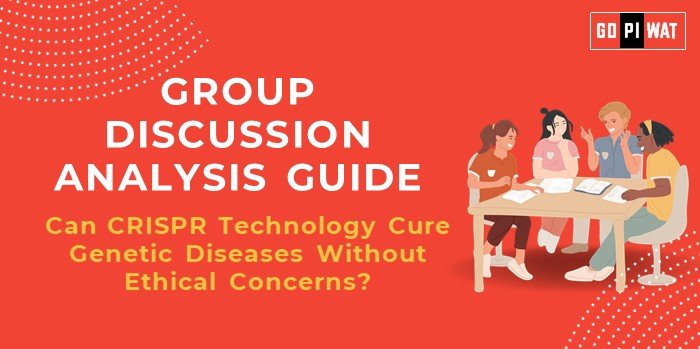📋 Group Discussion (GD) Analysis Guide: Can CRISPR Technology Cure Genetic Diseases Without Ethical Concerns?
🌐 Introduction to the Topic
- Context: CRISPR (Clustered Regularly Interspaced Short Palindromic Repeats) has revolutionized genetic engineering by offering precise, low-cost gene-editing tools. Its potential in curing genetic diseases like cystic fibrosis and sickle cell anemia is undeniable, yet ethical concerns remain prominent, such as germline editing and unintended genetic consequences.
- Background: Discovered in the early 2000s, CRISPR was adapted into a gene-editing tool by 2012, earning Jennifer Doudna and Emmanuelle Charpentier the Nobel Prize in Chemistry in 2020. Today, it’s being researched globally for therapeutic applications, including human trials for sickle cell disease and beta-thalassemia.
📊 Quick Facts and Key Statistics
- 📅 Discovery Year: 2012 – Adaptation for genome editing.
- 🔬 Therapeutic Trials: Over 30 clinical trials worldwide, focusing on genetic diseases.
- 💰 Cost Efficiency: CRISPR experiments cost 10-100x less than older methods like ZFN and TALEN.
- 📈 Global Market: Expected to reach $11 billion by 2030, growing at a CAGR of 19.3%.
- ✅ Success Cases: First human trials cured beta-thalassemia patients off regular blood transfusions.
👥 Stakeholders and Their Roles
- 💻 Scientists and Researchers: Innovating and refining the technology to minimize risks.
- 🏥 Medical Institutions: Conducting trials and integrating gene-editing therapies into clinical practice.
- 🏛️ Governments: Setting regulations to ensure safe and ethical use of CRISPR.
- 🙋♂️ Patients: Beneficiaries but potentially vulnerable to risks or ethical lapses.
- ⚖️ Ethics Committees: Balancing medical advancement with societal and moral boundaries.
🏆 Achievements and Challenges
✨ Achievements
- Medical Breakthroughs: Clinical success in curing beta-thalassemia.
- Economic Accessibility: Lower costs allow widespread research.
- Global Collaboration: Shared resources for better regulations.
⚠️ Challenges
- Ethical Dilemmas: Germline editing raises concerns about eugenics.
- Unintended Edits: Off-target mutations could cause cancer or other diseases.
- Global Disparities: Regulatory standards vary widely.
🌍 Global Comparisons
• China: Aggressive CRISPR research, including controversial human trials.
• USA: Stringent FDA oversight, focusing on somatic cell editing.
Case Study: In 2018, the birth of CRISPR-edited twins in China highlighted the dangers of unregulated germline editing.
📚 Structured Arguments for Discussion
- 💪 Supporting Stance: “CRISPR technology offers unparalleled precision in eliminating genetic diseases, ensuring long-term health improvements.”
- ❌ Opposing Stance: “Unregulated CRISPR use risks unintended mutations and sets dangerous precedents for germline editing.”
- ⚖️ Balanced Perspective: “While CRISPR’s potential to cure diseases is immense, rigorous ethical frameworks must govern its use.”
💡 Effective Discussion Approaches
- 📊 Opening Approaches:
- “CRISPR’s capability to edit human genes has opened the door to curing genetic diseases. The question is whether the cost of ethics is too high.”
- “With clinical success stories, CRISPR proves its worth in treating diseases, but ethical considerations require urgent global collaboration.”
- 🎯 Counter-Argument Handling:
- Rebut ethical concerns by citing ongoing improvements in CRISPR precision.
- Acknowledge risks but emphasize controlled, somatic cell research.
🔍 Strategic Analysis (SWOT)
- ✅ Strengths: Precise editing, cost efficiency, wide applications.
- ❌ Weaknesses: Ethical concerns, technical risks like off-target effects.
- 🚀 Opportunities: Global collaboration, new therapeutic areas.
- ⚠️ Threats: Public mistrust, misuse, regulatory gaps.
🎓 Connecting with B-School Applications
- 📌 Applications: Useful for healthcare strategy projects, bioethics studies, and technology policy frameworks.
- ❓ Sample Questions:
- “How can CRISPR address global health disparities?”
- “What regulatory framework would you recommend for CRISPR technologies?”
- 📘 Insights:
- Explore potential in healthcare consulting, medical innovation strategies, or policy development roles.


